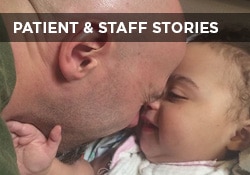This website uses cookies so that we can provide you with the best user experience possible. Cookie information is stored in your browser and performs functions such as recognising you when you return to our website and helping our team to understand which sections of the website you find most interesting and useful.

Susan E. Mazer, Ph.D. Blog
Thoughts and ideas on healthcare
Hi, and welcome to my blog! I'm Susan E. Mazer -- a knowledge expert and thought leader on how the environment of care impacts the patient experience. Topics I write about include safety, satisfaction, hospital noise, nursing, care at the bedside, and much more.
7 Things You Can Do To Support Shared Decision-Making
September 22, 2017
 This month, Mayo Clinic’s medical education journal published an article by Texas A&M Professor Leonard L. Berry and others about “Hostage Bargaining Syndrome” (HBS).
This month, Mayo Clinic’s medical education journal published an article by Texas A&M Professor Leonard L. Berry and others about “Hostage Bargaining Syndrome” (HBS).
HBS is what happens when the power differential between physicians and patients is perceived to be a barrier to shared decision-making.
The only difference between patients and their caregivers – whether physicians, nurses, or family – is acuity. Equality is experienced in our common humanity and can be evidenced in shared knowledge, mutual respect, and trust.
Fear and confusion plague the patient experience if there is no path for relief from HBS.
Withholding of Critical Information
According to Berry and his colleagues, one of the risks for patients experiencing HBS is withholding of critical information about themselves that are needed to accurately inform medical decisions. Patients may under-report symptoms (pain, nausea, anxiety), or a detail about their personal or family history in order to protect themselves.
The U.S. healthcare system has tremendous power over patients. Often it decides whether to see or not see a patient, how quickly to provide care, and sometimes delivers better care to those patients who can pay. The assumption that clinicians are smarter and know more than the patient is, in part, what makes the healthcare system intimidating.
Add to that the overwhelming fear that comes with any healthcare crisis.
Learned-helplessness hides inside HBS. It shows itself in extreme passivity and a lack of hope because patients no longer feel that they can affect their own condition. From at 2001 article in Health Affairs, “Clinical outcomes are best improved when the patient is both ‘informed and activated.'”
What About the Physical Environment?
Berry and his colleagues offer communication techniques for “freeing the hostages” and engaging in shared decision-making, but do not mention the design of the physical environment itself. Creating an environment that supports and expresses compassion and empathy, facilitates personal and authentic communication, and offers hope is essential to reduce the risks associated with unempowered patients.
Here are seven things you can do to help facilitate shared decision-making, some of which are about the physical environment:
- Intentionally create a close, compassionate relationship to build trust that can last throughout the hospitalization and beyond. Berry writes, “Trust is an essential element in giving patients confidence in their relationship with a clinician.”
- Make sure that there are minimal distractions during conversations with the patient and family. Be willing to repeat whatever the patient is unsure of.
- Have eye contact during a conversation, or at least do not speak to the back of the patient. Many patients and their families listen with both ears and eyes.
- Keep the room clean out of respect for the patient. An unclean room cannot be trusted and, therefore, undermines the relationship that is so important to establish.
- Listen and respond to patient concerns without interruption from you or anyone else. Ask meaningful questions to ensure you have understood and the patient knows that you have heard them.
- Provide positive distractions, such as The C.A.R.E. Channel, so that in the many hours patients are alone, they have support. The room is a primary caregiver when you are not in it.
- Remember what patients tell you, repeat what they say when they say it, and ask again on the next visit.
What else would you add to this list?
P.S. If you like this post, please do me a favor and share on LinkedIn, Twitter, Facebook, etc. Also to get automatic notices when a new post is published, please subscribe. No spam – just great content. Thanks!










